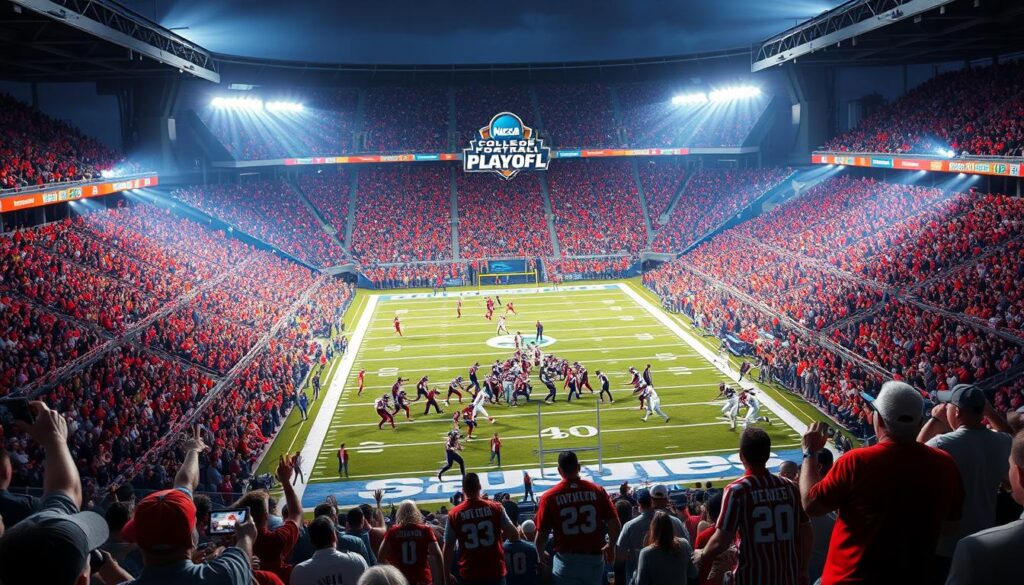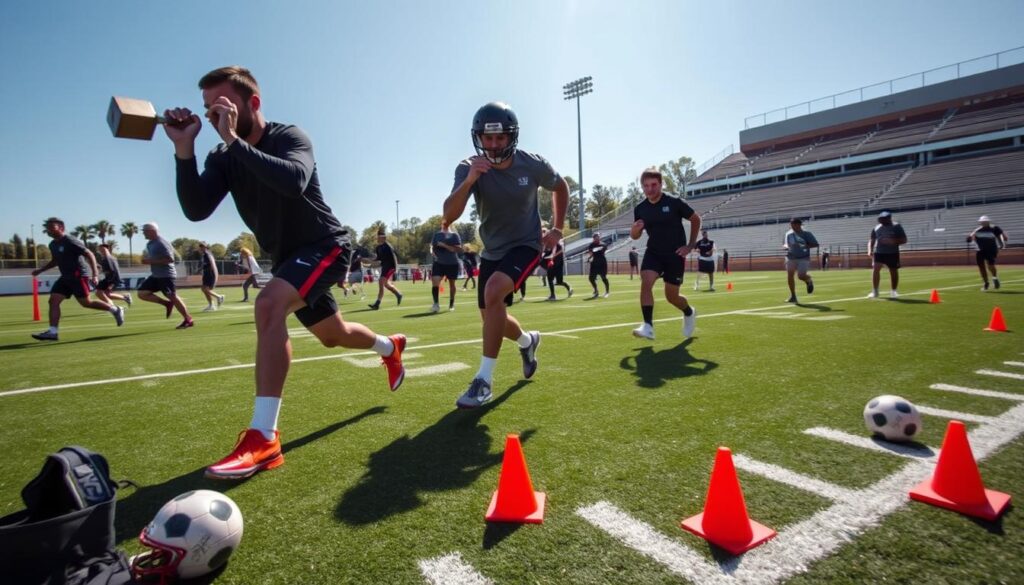Football is more than just a game in America. It’s a symbol of the nation’s culture. Starting from rugby, American football has grown into a fast-paced, competitive sport. It shows off the best in athleticism, strategy, and passion.
As the NFL and college football teams compete in the football2024 season, this guide explores the sport’s history, rules, and impact. It reveals how football has become a big part of American life.
Key Takeaways
- Discover the origins and evolution of American football, tracing its roots from rugby to the modern game.
- Understand the fundamental rules and gameplay of the sport, including the roles of offensive, defensive, and special teams players.
- Explore the strategic nuances and tactical approaches that make football a game of chess as well as physical dominance.
- Delve into the structure and organization of the NFL, as well as the college football championship system.
- Learn about the essential equipment, safety measures, and training techniques that shape the modern football player.
- Examine the transformative role of technology in the sport, from video review systems to performance analytics.
- Uncover the deep-rooted cultural significance of football in American society and its enduring legacy.
The Origins and Evolution of American Football
American football has a rich history that started with rugby. It grew from a small game to a national favorite. This shows its lasting appeal and the creativity of its founders.
From Rugby Roots to Modern Game
The game of American football began with rugby in the 19th century. Students from England brought rugby to the U.S. In 1869, Rutgers and Princeton played the first college football game. This was the start of American football’s journey.
Key Historical Milestones
- 1882: Walter Camp, known as the “Father of American Football,” introduced many rule changes. These changes made the game different from rugby and shaped its modern form.
- 1920: The American Professional Football Association (APFA), the NFL’s predecessor, was founded. This marked the beginning of the sport’s professional era.
- 1967: The first Super Bowl was played. It quickly became the most-watched sporting event in the U.S.
Evolution of Rules and Equipment
American football has seen many rule and equipment changes over the years. These changes have made the game safer and more exciting. From the forward pass to advanced protective gear, the game has evolved to keep fans interested.
The history of American football shows the passion and innovation of its creators. From its early days to today, the game has grown. It’s a story of constant improvement and a deep love for the sport.
Understanding Basic Football Rules and Gameplay
Football is a complex sport, but knowing its basic rules is crucial. It involves the downs system, scoring, and penalties. Let’s explore these key elements that shape the game.
The football field is 100 yards long, with 10-yard end zones on each side. Teams have four downs to move the ball 10 yards. If they succeed, they get another four downs. If not, the other team gets the ball.
Scoring in football can happen in several ways. A touchdown, worth 6 points, is scored by carrying the ball into the end zone or catching a pass there. After a touchdown, the team can try a 1-point conversion by running or passing into the end zone again. Or, they can go for a 2-point conversion from the 2-yard line.
| Scoring Method | Points Awarded |
|---|---|
| Touchdown | 6 points |
| Extra Point (1-point conversion) | 1 point |
| 2-Point Conversion | 2 points |
| Field Goal | 3 points |
| Safety | 2 points |
Football also has penalties that officials can call. These include offside, holding, pass interference, and personal fouls. Penalties can lead to losing yardage, downs, or even being kicked out of the game.
“Football is a game of inches. Every single play counts, and you have to give it your all on every down.”
Knowing the basic rules and gameplay of football is key to enjoying the sport. It reveals the strategies and nuances that make it exciting to watch and play.
Football Positions and Player Roles
Football is a complex game with many player positions. Each position is vital for the team’s success. Knowing the roles and responsibilities of these positions is key for fans and aspiring players.
Offensive Player Positions
The quarterback leads the offense, calling plays and making quick decisions. Wide receivers catch passes downfield, using speed and agility. Running backs carry the ball, gaining yards and scoring touchdowns.
Defensive Player Positions
Defensively, linebackers stop the run, cover receivers, and blitz the quarterback. Defensive linemen disrupt the offense, occupying blockers and penetrating the backfield. Defensive backs, including cornerbacks and safeties, cover wide receivers and protect against passes.
Special Teams Players
Special teams players have a unique role. The kicker handles field goals, extra points, and kickoffs. The punter controls field position with their kicks. Coverage and return teams are also crucial on kickoffs and punts.
Each football position requires specific skills and attributes. These contribute to the team’s harmony and success. Exploring these roles deepens our appreciation for football’s strategy and athleticism.
Essential Football Strategies and Tactics
In American football, success isn’t just about talent. It’s also about strategy. The football playbook is key, filled with plans to outsmart opponents.
Offensive strategies help teams score. Coaches use the West Coast offense and I-formation to play to their strengths. Defensive schemes, like the 4-3 defense and 3-4 defense, protect the end zone.
Play-calling is a coach’s art. They read the game and make quick decisions. Being able to change the game plan is crucial in football.
Teams’ success comes from careful planning. Coaches create detailed football playbooks. This gives teams the edge they need to win.
NFL Structure and football2024 Season Guide
The National Football League (NFL) is the top of American football. It has a complex structure that draws fans from all over. The NFL’s divisions and conferences lead to the thrilling Super Bowl LVIII in 2024.
League Organization
The NFL splits into two conferences: the American Football Conference (AFC) and the National Football Conference (NFC). Each has four divisions: North, South, East, and West. With 32 teams, each division has four teams fighting for the Super Bowl title.
Regular Season Format
The NFL regular season starts in early September and ends in early January. Each team plays 17 games in 18 weeks. This leads to the Wild Card playoffs, where top teams from each conference compete for the Super Bowl LVIII.
Playoff System
The NFL playoff system is a multi-tiered format. It decides the two teams for the Super Bowl LVIII finale. The best teams from each conference play, with the AFC and NFC champions facing off in the biggest game.
“The journey to the Super Bowl is a true test of a team’s resilience, strategy, and skill. The playoff system is where legends are made and dynasties are cemented.”
College Football Championship System
The NCAA is the top body for college sports in the U.S. College football reaches its peak with the College Football Playoff (CFP). This system finds the national champion.
The CFP pits four top teams against each other. They’re picked based on their regular season, strength of schedule, and more. The winners of the semifinals play in the National Championship game.
Bowl games add to the excitement of college football. Games like the Rose Bowl and Sugar Bowl are filled with tradition and talent. They draw huge crowds and highlight the best of college football.
The Heisman Trophy is a big deal in college football. It’s given to the best player each year. Winners often go on to great careers in the NFL.
College football and the NFL are closely linked. The NFL is where many top players end up. The NCAA and NFL work together to grow football talent.
| Championship System | Key Features |
|---|---|
| College Football Playoff (CFP) |
|
| Bowl Games |
|
| Heisman Trophy |
|

The college football championship system is thrilling. It combines competition, tradition, and individual excellence. From the College Football Playoff to the Heisman Trophy, it’s a beloved American sport.
Football Equipment and Safety Measures
Player safety is a top priority in America’s favorite sport. Football equipment, like the football helmet and shoulder pads, is key to protecting athletes. As the sport grows, so do the safety rules and gear.
Protective Gear Requirements
At all levels, from youth to pros, players must wear a lot of protective gear. This includes helmets, shoulder pads, mouthguards, and special padding for hips, knees, and elbows. The gear must meet strict safety standards to reduce injury risks.
Safety Protocols and Regulations
Football has strict safety rules to keep players safe. The concussion protocol requires thorough checks for head injuries. It also has clear rules for when players can return to the game. Research on CTE has led to more focus on preventing injuries.
Injury Prevention Strategies
- Proper technique and form in tackling and blocking
- Increased emphasis on conditioning and strength training
- Advancements in protective equipment design and materials
- Continuous monitoring and enforcement of safety regulations
- Collaboration between coaches, medical professionals, and researchers
Football’s commitment to safety is unwavering. With the right gear, strict rules, and new ways to prevent injuries, the game is safer for everyone.
| Protective Gear | Purpose | Key Features |
|---|---|---|
| Football Helmet | Head and brain protection | Impact-absorbing materials, face mask, chin strap |
| Shoulder Pads | Upper body protection | Rigid shell, foam padding, adjustable straps |
| Mouthguard | Oral and dental protection | Customized fit, impact-resistant material |
| Hip, Knee, and Elbow Pads | Additional joint and limb protection | Flexible, shock-absorbing padding |
Training and Conditioning for Football Players
Football is a demanding sport that needs strength, speed, and agility. Players follow strict training and conditioning to stay at their best. These programs focus on different parts of their athletic skills.
Strength Training for Football
Strength training is key for football players. Squats, deadlifts, and bench presses build muscle for explosive moves. They also boost overall strength, reducing injury risk.
Speed and Agility Drills
Players also do speed and agility drills. These include sprints, ladder drills, and cone drills. They improve footwork, coordination, and reaction time.
Nutrition and Recovery
Nutrition and recovery are vital for football players. A balanced diet with lean proteins, carbs, and fats fuels intense training. Enough rest and recovery help muscles repair and rebuild, keeping players ready for games.
| Training Component | Key Exercises and Activities | Benefits |
|---|---|---|
| Strength Training |
|
|
| Speed and Agility |
|
|
| Nutrition and Recovery |
|
|
By focusing on strength, speed, agility, and nutrition, football players can excel. They stay competitive all season long.

“The key to success in football is not just talent, but the dedication and discipline to constantly improve your physical abilities through rigorous training and proper nutrition.”
The Impact of Technology in Modern Football
Football has changed a lot in recent years because of new technology. Video review systems help make calls fairer. Advanced analytics track how players perform, changing the game at all levels.
Video Review Systems
The NFL’s instant replay system is a big change. It lets officials make better calls, making the game fairer. This tech is key for referees and makes watching games better for fans.
Player Performance Analytics
NFL Next Gen Stats gives deep insights into how players do. It uses sensors to track speed, acceleration, and more. This helps teams make smarter choices and understand the game better.
Fan Experience Innovations
Technology has changed how fans watch football. Virtual reality lets fans see games from new angles. They can also get exclusive content, making their experience more interactive and fun.
Technology will keep changing football. It will improve officiating, player analysis, and the fan experience. The future of football will be shaped by the latest football tech.
The Cultural Impact of Football in America
Football is more than a sport in the United States. It’s a big part of American culture. From the fun tailgating before Super Bowl Sunday to the rise of fantasy football leagues, football’s influence goes beyond the game.
The football culture in America shines during the Super Bowl. This event is one of the most watched TV events. The commercials during the game are a big deal, with companies trying to make the most memorable ads.
- Tailgating, the tradition of gathering in parking lots to cook, socialize, and get pumped up before the game, has become a cherished ritual for football fans across the country.
- The rise of fantasy football leagues has further cemented the sport’s place in popular culture, as fans engage in friendly competition and debate the merits of various players and teams.
| Football Culture Phenomenon | Impact on American Society |
|---|---|
| Super Bowl Commercials | Showcase the latest trends and cultural touchpoints, becoming a talking point for the nation. |
| Tailgating Traditions | Bring communities together, fostering social connections and a shared sense of camaraderie. |
| Fantasy Football Leagues | Enhance fan engagement, creating a sense of ownership and investment in the sport. |
Football’s impact on American culture is clear. It brings people together, sparks conversations, and shows the changing values and interests of the nation.
The Future of Football: Trends and Challenges
Football2024 is changing fast, with many trends and challenges ahead. Keeping players safe is key, with better gear and rules to protect them. The sport is also growing worldwide, bringing both chances and hurdles for the NFL and colleges.
Football needs to be more diverse and inclusive. More women should play and lead, making the game fair for everyone. New tech, like video reviews and player data, will change how we watch and play football.
As football2024 moves forward, everyone involved must keep its traditions alive while embracing new ideas. By focusing on safety, reaching more fans globally, and welcoming diversity and tech, football’s future looks bright and exciting.




